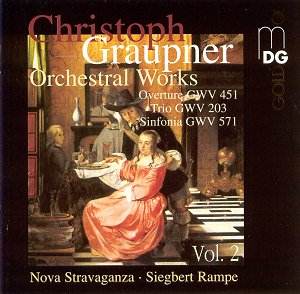Christoph Graupner
was one of the most prolific composers
in Germany of his time. He wrote a large
number of instrumental and vocal works,
which until the last five years or so
have been almost completely neglected.
Born in Kirchberg in
Saxony he received his first music lessons
from local musicians, and then went
to Leipzig in 1696 as an alumnus of
the Thomasschule. The time in Leipzig
turned out to be crucial for his development
as a musician and composer.
Here he became acquainted
with Telemann, who was the leader of
the local Collegium Musicum. Perhaps
it is through Telemann that Graupner
got interested in French music, as is
evident from the number of orchestral
overtures in French style he has composed.
Another similarity between Telemann
and Graupner is the writing for a wide
variety of instruments, among them less
common ones like the viola d'amore and
the chalumeau.
Together with his friend
Johann David Heinichen he studied with
the then Thomaskantor Johann Kuhnau,
who thoroughly instructed them in counterpoint.
In his autobiography Graupner writes
that "both I and Heinichen had much
profit from his teachings, both for
harpsichord and composition. I myself
also offered Kuhnau to copy out music
and wrote for him for some time. I thus
had the opportunity to note many things
and whenever I had a doubt, I asked
him to explain so that I knew how this
or that was to be understood."
The study of counterpoint
had a lasting influence on Graupner.
Just like Heinichen he developed a special
interest in the canon. In 1730 he started
to write 5625 canons on the same subject.
And in 1736 he copied Kuhnau's treatise
'Von dem doppelten Contrapunct', which
was circulating only in manuscript.
This is most remarkable, as at that
time the aesthetic of the Enlightenment
quickly won ground. Its main theorist
was Johann Mattheson, who, in 1723 in
his journal 'Critica Musica', specifically
wrote that the foundation of music is
not the canon but melody and that the
ability to write a melody owes little
or nothing to the artifice of the canon.
It shouldn't be concluded
from this that Graupner was a conservative
composer. After working three years
in Hamburg at the Opera, he went to
Darmstadt, where he became the Hofkapellmeister
at the court of the Landgrave of Hesse-Darmstadt.
It is here that he wrote the main part
of his oeuvre, and this demonstrates
he - like Telemann and Bach - was in
favour of a mixture of national styles,
in particular the French and the Italian.
And over the years his compositional
style clearly changed, but gradually.
Apparently he preferred evolution over
revolution.
The trio sonata recorded
here, probably composed around 1744,
is traditional in its use of imitation,
but in its three-movement structure
(fast - slow - fast) it breaks away
from tradition. The Overture which opens
this recording, also contains some less
usual elements. The structure of the
overture wasn't formalised, with the
exception of the first movement, called
'ouverture', which was always written
in ABA-form, as it is here. But what
followed was to the choice of the composer.
Remarkable is the fact that we don't
find here just a pair of menuets, but
four of them. Even more striking is
the scoring: transverse flute, viola
d'amore, 2 chalumeaus, horn, 2 violins,
viola and basso continuo. The chalumeau
was a relatively new instrument at that
time (around 1735), and Graupner developed
a great love for its soft-edged sound.
And it was rather unusual to write just
one part for the horn - in most orchestral
works horns played in pairs. The horn
part is extremely virtuosic, in particular
in its range, which reflects the brilliance
of the horn players at the court in
Darmstadt, Mahler and Schwarz.
The Overture displays
a particular feature of Graupner's style:
the use of very short motifs, which
the contemporary theorist Adlung described
as 'short and sweet ideas'. This structure
makes Graupner's music somewhat unpredictable,
therefore interesting, but also less
easy to remember than that of most of
his contemporaries. In this Overture
that characteristic is even enhanced
by the fact that the motivic material
is divided over all instruments involved.
Most of Graupner's
Sinfonias date from the 1740s and 1750s.
Some of these were recorded in the first
volume which was released in 2002, and
are reminiscent of the style of the
Mannheim school. The Sinfonia performed
here is a reworking of an Overture,
which dates probably from before 1730
- only the first movement (largo - allegro
- largo) is new. The date of its composition
is reflected by the second movement,
which is a fugato. This composition
is another example of Graupner's talent
for instrumentation, in particular when
transverse flutes and oboes contrast
with the strings playing pizzicato.
This recording impressively
proves that Graupner isn't just a 'minor
master' of the 18th century in Germany,
and more than 'a contemporary of Bach
and Telemann'. He was a very distinguished
composer whose works considerably add
to the picture of musical styles and
compositional developments in Germany
in the period from about 1725 to 1760.
The playing of Nova Stravaganza is outstanding,
and does full justice to the brilliance
of these scores. The solo parts are
all superbly played, and the ensemble
playing is impeccable. This release
shows a great zest on the part of everyone
involved. It must have been a great
privilege to play this fine music for
the first time ever. One can just hope
that more will follow, and that others
may be encouraged to perform more of
Graupner's output which is awaiting
to be rediscovered in the archives in
Darmstadt.
Johan van Veen







